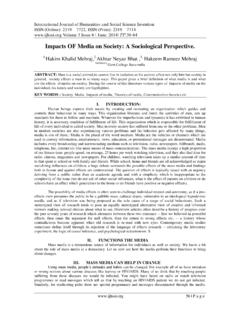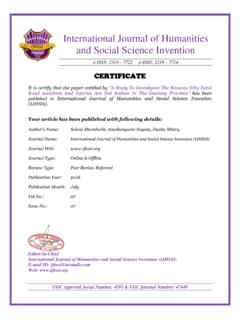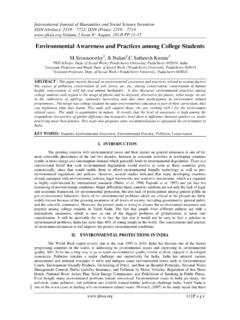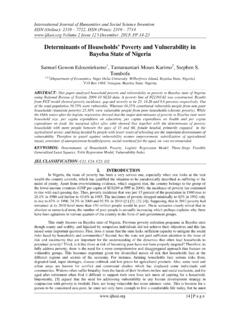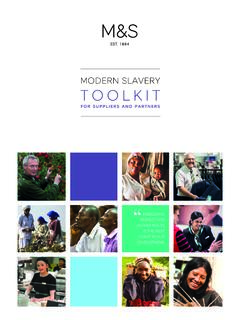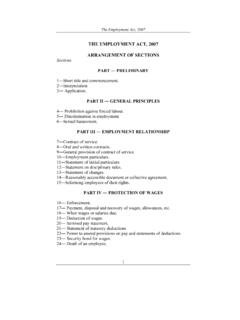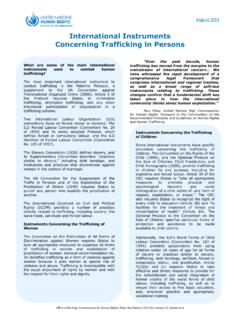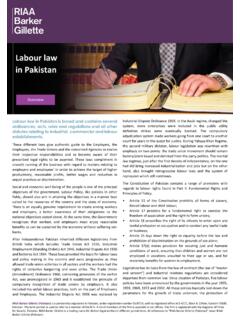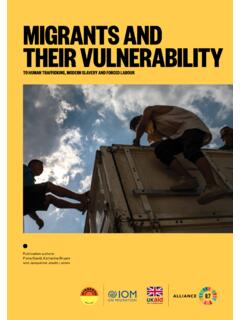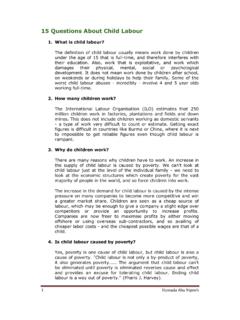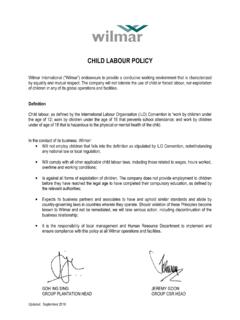Transcription of Child Labour in India A Conceptual and Descriptive Study
1 International Journal of Humanities and Social Science Invention ISSN (Online): 2319 7722, ISSN (Print): 2319 7714 Volume 4 Issue 1 January. 2015 23 | Page Child Labour in India A Conceptual and Descriptive Study Dr. Parvathamma, Associate professor, Department of Economics, Bangalore , Kolar-563101 ABSTRACT : Child Labour refers to the employment of children in any work that deprives children of their childhood, interferes with their ability to attend regular school, and that is mentally, physically, socially or morally dangerous and harmful. Of an estimated 215 Child laborers around the globe: approximately 114 million (53%) are in Asia and the Pacific; 14 million (7%) live in Latin America; and 65 million (30%) live in sub-Saharan Africa. Global number of children in Child Labour has declined by one third since 2000, from 246 million to 168 million children.
2 More than half of them, 85 million, are in hazardous work (down from 171 million in 2000).Asia and the Pacific still has the largest numbers (almost 78 million or of Child population), but Sub-Saharan Africa continues to be the region with the highest incidence of Child Labour (59 million, over 21%).There are 13 million ( ) of children in Child Labour in Latin America and the Caribbean and in the Middle East and North Africa there are million ( ).Agriculture remains by far the most important sector where Child labourers can be found (98 million, or 59%), but the problems are not negligible in services (54 million) and industry (12 million) mostly in the informal economy. Child Labour among girls fell by 40% since 2000, compared to 25%for boys. Child Labour in India is addressed by the Child Labour Act 1986 and National Child Labour project. Today in India , there are more than million children who are spending their childhood learning carpet-weaving, beedi-rolling, domestic Labour , agriculture, firework and apparel manufacture and countless other occupations instead of going to school and receiving quality education.
3 In this back ground, the present paper , in Section I, highlights the characteristic and causes for Child lanbour,Section II,Analyses the Problem of Child Labor in India , bonded Child Labour , consequences and exploitation of Child Labour .Lastly Section III mainly focused on policy initiatives of government of India to protect Child Labour . KEYWORDS: Child Labour , Bonded Child Labour , National Child Labour project, National Child Labour Policy I. INTRODUCTION; Child Labour refers to the employment of children in any work that deprives children of their childhood, interferes with their ability to attend regular school, and that is mentally, physically, socially or morally dangerous and harmful. This practice is considered exploitative by many international. Legislations across the world prohibit Child Labour . These laws do not consider all work by children as Child Labour ; exceptions include work by Child artists, supervised training, certain categories of work such as those by Amish children, some forms of Child work common among indigenous American children, and others.
4 Child Labour in India is addressed by the Child Labour Act 1986 and National Child Labour project. Today in India , there are more than after million children who are spending their childhood learning carpet-weaving, beedi-rolling, domestic Labour , agriculture, firework and apparel manufacture and countless other occupations instead of going to school and receiving quality education. Child labor is work that harms children or keeps them from attending school. Around the world and in the U. S., growing gaps between rich and poor in recent decades have forced millions of young children out of school and into work. The International Labor Organization estimates that 215 million children between the ages of 5 and 17 currently work under conditions that are considered illegal, hazardous, or extremely exploitative. Underage children work at all sorts of jobs around the world, usually because they and their families are extremely poor.
5 Large numbers of children work in commercial agriculture, fishing, manufacturing, mining, and domestic service. Some children work in illicit activities like the drug trade and prostitution or other traumatic activities such as serving as soldiers. Of an estimated 215 Child laborers around the globe: approximately 114 million (53%) are in Asia and the Pacific; 14 million (7%) live in Latin America; and 65 million (30%) live in sub-Saharan Africa. Global number of children in Child Labour has declined by one third since 2000, from 246 million to 168 million children. More than half of them, 85 million, are in hazardous work (down from 171 million in 2000).Asia and the Pacific still has the largest numbers (almost 78 millionor of Child population), but Sub-Saharan Africa continues to be the region with the highest incidence of Child Labour (59 million, over 21%).There are 13 million ( ) of children in Child Labour in Latin America and the Caribbean and in the Middle East and North Africa there are million ( ).
6 Agriculture remains by far the most important sector where Child Labour In India A 24 | Page Child labourers can be found (98 million, or 59%), but the problems are not negligible in services (54 million) and industry (12 million) mostly in the informal Labour among girls fell by 40% since 2000, compared to 25%for boys. Characteristics of Child Labour ; Child Labour involves at least one of the following: Violates a nation s minimum wage laws Threatens children s physical, mental, or emotional well-being Involves intolerable abuse, such as Child slavery, Child trafficking, debt bondage, forced labor, or illicit activities Prevents children from going to school Uses children to undermine labor standards Child Labour can be found in nearly every industry. An estimated 60% of Child labor occurs in agriculture, fishing, hunting, and forestry.
7 Children have been found harvesting: bananas in Ecuador, cotton in Egypt and Benin, cut flowers in Colombia, oranges in Brazil, cocoa in the Ivory Coast, tea in Argentina and Bangladesh, Fruits and vegetables in the in commercial agriculture can face long hours in extreme temperatures, health risks from pesticides, little or no pay, and inadequate food, water, and sanitation. Manufacturing; About 14 million children are estimated to be directly involved in manufacturing goods, including: Carpets from India , Pakistan, Egypt, Clothing sewn in Bangladesh; footwear made in India and the Philippines ,Soccer balls sewn in Pakistan, Glass and bricks made in India , Fireworks made in China, the Dominican Republic, El Salvador, Guatemala, India , and Peru, Surgical instruments made in Pakistan. Mining and Quarrying; Child laborers suffer extremely high illness and injury rates in underground mines, opencast mines, and quarries.
8 Children as young as 6 or 7 years old break up rocks, and wash, sieve, and carry ore. Nine-year-old work underground setting explosives and carrying loads. Children work in a range of mining operations, including:;Gold in Colombia, Charcoal in Brazil and El Salvador, Chrome in Zimbabwe, Diamonds in Cote d Ivoire,Emeralds in Colombia, Coal in Mongolia. According to HAQ, centre for Child rights, Child Labour is highest among schedule tribes, castes and OBC children. The persistence of Child Labour is due to the inefficiency of law, administrative system and because it benefits employers who can reduce general wage argues that distinguish between hazardous and non hazardous employment is counter productive to the elimination of Child growing concerns have pushed children out of school an into employment such as forced displacement due to development projects ,special Economic zones, loss of jobs of parents in a slow down, farmers suicide ,armed conflict and highest cost of health care.
9 Girl children are often used in domestic Labour with in their homes. There is a lack of political will to actually see to complete ban of Child Labour . II. CAUSES FOR Child Labour Primary causes: International Labour Organisation (ILO) suggests poverty is the greatest single cause behind Child Labour . For impoverished households, income from a Child 's work is usually crucial for his or her own survival or for that of the household. Income from working children, even if small, may be between 25 to 40% of the household income. Other scholars such as Harsch on African Child Labour , and Edmonds and Pavcnik on global Child Labour have reached the same conclusion. Lack of meaningful alternatives, such as affordable schools and quality education, according to ILO, is another major factor driving children to harmful Labour . Children work because they have nothing better to do. Many communities, particularly rural areas where between 60 70% of Child Labour is prevalent, do not possess adequate school facilities.
10 Even when schools are sometimes available, they are too far away, difficult to reach, unaffordable or the quality of education is so poor that parents wonder if going to school is really worth it. Cultural causes : In European history when Child Labour was common, as well as in contemporary Child Labour of modern world, certain cultural beliefs have rationalized Child Labour and thereby encouraged it. Some view that work is good for the character-building and skill development of children. In many cultures, particular where informal economy and small household businesses thrive, the cultural tradition is that children follow in their parents' footsteps; Child Labour then is a means to learn and practice that trade from a very early age. Similarly, in many cultures the education of girls is less valued or girls are simply not expected to need formal schooling, and these girls pushed into Child Labour such as providing domestic services.


